The Minerals Portal
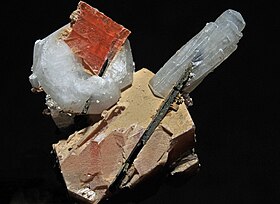
In geology and mineralogy, a mineral or mineral species is, broadly speaking, a solid substance with a fairly well-defined chemical composition and a specific crystal structure that occurs naturally in pure form.
The geological definition of mineral normally excludes compounds that occur only in living organisms. However, some minerals are often biogenic (such as calcite) or organic compounds in the sense of chemistry (such as mellite). Moreover, living organisms often synthesize inorganic minerals (such as hydroxylapatite) that also occur in rocks.
The concept of mineral is distinct from rock, which is any bulk solid geologic material that is relatively homogeneous at a large enough scale. A rock may consist of one type of mineral or may be an aggregate of two or more different types of minerals, spacially segregated into distinct phases.
Some natural solid substances without a definite crystalline structure, such as opal or obsidian, are more properly called mineraloids. If a chemical compound occurs naturally with different crystal structures, each structure is considered a different mineral species. Thus, for example, quartz and stishovite are two different minerals consisting of the same compound, silicon dioxide. (Full article...)
Mineralogy is a subject of geology specializing in the scientific study of the chemistry, crystal structure, and physical (including optical) properties of minerals and mineralized artifacts. Specific studies within mineralogy include the processes of mineral origin and formation, classification of minerals, their geographical distribution, as well as their utilization. (Full article...)
Selected articles
-
Image 1
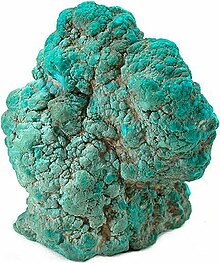
Turquoise is an opaque, blue-to-green mineral that is a hydrous phosphate of copper and aluminium, with the chemical formula CuAl6(PO4)4(OH)8·4H2O. It is rare and valuable in finer grades and has been prized as a gemstone for millennia due to its hue.
Like most other opaque gems, turquoise has been devalued by the introduction of treatments, imitations, and synthetics into the market. The robin egg blue or sky blue color of the Persian turquoise mined near the modern city of Nishapur, Iran, has been used as a guiding reference for evaluating turquoise quality. (Full article...) -
Image 2

Talc, or talcum, is a clay mineral composed of hydrated magnesium silicate, with the chemical formula Mg3Si4O10(OH)2. Talc in powdered form, often combined with corn starch, is used as baby powder. This mineral is used as a thickening agent and lubricant. It is an ingredient in ceramics, paints, and roofing material. It is a main ingredient in many cosmetics. It occurs as foliated to fibrous masses, and in an exceptionally rare crystal form. It has a perfect basal cleavage and an uneven flat fracture, and it is foliated with a two-dimensional platy form.
The Mohs scale of mineral hardness, based on scratch hardness comparison, defines value 1 as the hardness of talc, the softest mineral. When scraped on a streak plate, talc produces a white streak, though this indicator is of little importance, because most silicate minerals produce a white streak. Talc is translucent to opaque, with colors ranging from whitish grey to green with a vitreous and pearly luster. Talc is not soluble in water, and is slightly soluble in dilute mineral acids.
Soapstone is a metamorphic rock composed predominantly of talc. (Full article...) -
Image 3A lustrous crystal of zircon perched on a tan matrix of calcite from the Gilgit District of Pakistan
Zircon (/ˈzɜːrkɒn, -kən/) is a mineral belonging to the group of nesosilicates and is a source of the metal zirconium. Its chemical name is zirconium(IV) silicate, and its corresponding chemical formula is ZrSiO4. An empirical formula showing some of the range of substitution in zircon is (Zr1–y, REEy)(SiO4)1–x(OH)4x–y. Zircon precipitates from silicate melts and has relatively high concentrations of high field strength incompatible elements. For example, hafnium is almost always present in quantities ranging from 1 to 4%. The crystal structure of zircon is tetragonal crystal system. The natural color of zircon varies between colorless, yellow-golden, red, brown, blue, and green.
The name derives from the Persian zargun, meaning "gold-hued". This word is changed into "jargoon", a term applied to light-colored zircons. The English word "zircon" is derived from Zirkon, which is the German adaptation of this word. Yellow, orange, and red zircon is also known as "hyacinth", from the flower hyacinthus, whose name is of Ancient Greek origin. (Full article...) -
Image 4Dolomite (white) on talc
Dolomite (/ˈdɒl.əˌmaɪt, ˈdoʊ.lə-/) is an anhydrous carbonate mineral composed of calcium magnesium carbonate, ideally CaMg(CO3)2. The term is also used for a sedimentary carbonate rock composed mostly of the mineral dolomite (see Dolomite (rock)). An alternative name sometimes used for the dolomitic rock type is dolostone. (Full article...) -
Image 5
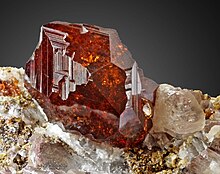
Garnets ( /ˈɡɑːrnɪt/) are a group of silicate minerals that have been used since the Bronze Age as gemstones and abrasives.
All species of garnets possess similar physical properties and crystal forms, but differ in chemical composition. The different species are pyrope, almandine, spessartine, grossular (varieties of which are hessonite or cinnamon-stone and tsavorite), uvarovite and andradite. The garnets make up two solid solution series: pyrope-almandine-spessartine (pyralspite), with the composition range [Mg,Fe,Mn]3Al2(SiO4)3; and uvarovite-grossular-andradite (ugrandite), with the composition range Ca3[Cr,Al,Fe]2(SiO4)3. (Full article...) -
Image 6Amethyst cluster from Artigas, Uruguay
Amethyst is a violet variety of quartz. The name comes from the Koine Greek αμέθυστος amethystos from α- a-, "not" and μεθύσκω (Ancient Greek) methysko / μεθώ metho (Modern Greek), "intoxicate", a reference to the belief that the stone protected its owner from drunkenness. Ancient Greeks wore amethyst and carved drinking vessels from it in the belief that it would prevent intoxification.
Amethyst, a semiprecious stone, is often used in jewelry. (Full article...) -
Image 7

Gypsum is a soft sulfate mineral composed of calcium sulfate dihydrate, with the chemical formula CaSO4·2H2O. It is widely mined and is used as a fertilizer and as the main constituent in many forms of plaster, drywall and blackboard or sidewalk chalk. Gypsum also crystallizes as translucent crystals of selenite. It forms as an evaporite mineral and as a hydration product of anhydrite. The Mohs scale of mineral hardness defines gypsum as hardness value 2 based on scratch hardness comparison.
Fine-grained white or lightly tinted forms of gypsum known as alabaster have been used for sculpture by many cultures including Ancient Egypt, Mesopotamia, Ancient Rome, the Byzantine Empire, and the Nottingham alabasters of Medieval England. (Full article...) -
Image 8
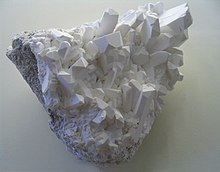
Borax (also referred to as sodium borate, tincal (/ˈtɪŋkəl/) and tincar (/ˈtɪŋkər/)) is a salt (ionic compound), a hydrated or anhydrous borate of sodium, with the chemical formula Na2H20B4O17 (also written as Na2B4O7·10H2O).
It is a colorless crystalline solid that dissolves in water to make a basic solution.
It is commonly available in powder or granular form and has many industrial and household uses, including as a pesticide, as a metal soldering flux, as a component of glass, enamel, and pottery glazes, for tanning of skins and hides, for artificial aging of wood, as a preservative against wood fungus, and as a pharmaceutic alkalizer. In chemical laboratories, it is used as a buffering agent.
The terms tincal and tincar refer to native borax, historically mined from dry lake beds in various parts of Asia. (Full article...) -
Image 9A sample of andesite (dark groundmass) with amygdaloidal vesicles filled with zeolite. Diameter of view is 8 cm.
Andesite (/ˈændəzaɪt/) is a volcanic rock of intermediate composition. In a general sense, it is the intermediate type between silica-poor basalt and silica-rich rhyolite. It is fine-grained (aphanitic) to porphyritic in texture, and is composed predominantly of sodium-rich plagioclase plus pyroxene or hornblende.
Andesite is the extrusive equivalent of plutonic diorite. Characteristic of subduction zones, andesite represents the dominant rock type in island arcs. The average composition of the continental crust is andesitic. Along with basalts, andesites are a component of the Martian crust.
The name andesite is derived from the Andes mountain range, where this rock type is found in abundance. It was first applied by Christian Leopold von Buch in 1826. (Full article...) -
Image 10

Cinnabar (/ˈsɪnəˌbɑːr/; from Ancient Greek κιννάβαρι (kinnábari)), or cinnabarite (/ˌsɪnəˈbɑːraɪt/), also known as mercurblende is the bright scarlet to brick-red form of mercury(II) sulfide (HgS). It is the most common source ore for refining elemental mercury and is the historic source for the brilliant red or scarlet pigment termed vermilion and associated red mercury pigments.
Cinnabar generally occurs as a vein-filling mineral associated with volcanic activity and alkaline hot springs. The mineral resembles quartz in symmetry and it exhibits birefringence. Cinnabar has a mean refractive index near 3.2, a hardness between 2.0 and 2.5, and a specific gravity of approximately 8.1. The color and properties derive from a structure that is a hexagonal crystalline lattice belonging to the trigonal crystal system, crystals that sometimes exhibit twinning.
Cinnabar has been used for its color since antiquity in the Near East, including as a rouge-type cosmetic, in the New World since the Olmec culture, and in China since as early as the Yangshao culture, where it was used in coloring stoneware.
Associated modern precautions for the use and handling of cinnabar arise from the toxicity of the mercury component, which was recognized as early as ancient Rome. (Full article...) -
Image 11Brazilian trigonal hematite crystal
Hematite (/ˈhiːməˌtaɪt, ˈhɛmə-/), also spelled as haematite, is a common iron oxide compound with the formula, Fe2O3 and is widely found in rocks and soils. Hematite crystals belong to the rhombohedral lattice system which is designated the alpha polymorph of Fe
2O
3. It has the same crystal structure as corundum (Al
2O
3) and ilmenite (FeTiO
3). With this it forms a complete solid solution at temperatures above 950 °C (1,740 °F).
Hematite naturally occurs in black to steel or silver-gray, brown to reddish-brown, or red colors. It is mined as an important ore mineral of iron. It is electrically conductive. Hematite varieties include kidney ore, martite (pseudomorphs after magnetite), iron rose and specularite (specular hematite). While these forms vary, they all have a rust-red streak. Hematite is not only harder than pure iron, but also much more brittle. Maghemite is a polymorph of hematite (γ-Fe
2O
3) with the same chemical formula, but with a spinel structure like magnetite.
Large deposits of hematite are found in banded iron formations. Gray hematite is typically found in places that have still, standing water or mineral hot springs, such as those in Yellowstone National Park in North America. The mineral can precipitate in the water and collect in layers at the bottom of the lake, spring, or other standing water. Hematite can also occur in the absence of water, usually as the result of volcanic activity.
Clay-sized hematite crystals can also occur as a secondary mineral formed by weathering processes in soil, and along with other iron oxides or oxyhydroxides such as goethite, which is responsible for the red color of many tropical, ancient, or otherwise highly weathered soils. (Full article...) -
Image 12

Zeolite exhibited in the Estonian Museum of Natural History
Zeolite is a family of several microporous, crystalline aluminosilicate materials commonly used as commercial adsorbents and catalysts. They mainly consist of silicon, aluminium, oxygen, and have the general formula Mn+
1/n(AlO
2)−
(SiO
2)
x・yH
2O where Mn+
1/n is either a metal ion or H+. These positive ions can be exchanged for others in a contacting electrolyte solution. H+
exchanged zeolites are particularly useful as solid acid catalysts.
The term was originally coined in 1756 by Swedish mineralogist Axel Fredrik Cronstedt, who observed that rapidly heating a material, believed to have been stilbite, produced large amounts of steam from water that had been adsorbed by the material. Based on this, he called the material zeolite, from the Greek ζέω (zéō), meaning "to boil" and λίθος (líthos), meaning "stone".
Zeolites occur naturally, but are also produced industrially on a large scale. , 253 unique zeolite frameworks have been identified, and over 40 naturally occurring zeolite frameworks are known. Every new zeolite structure that is obtained is examined by the International Zeolite Association Structure Commission (IZA-SC) and receives a three-letter designation. (Full article...) -
Image 13
A rock containing three crystals of pyrite (FeS2). The crystal structure of pyrite is primitive cubic, and this is reflected in the cubic symmetry of its natural crystal facets.
In crystallography, the cubic (or isometric) crystal system is a crystal system where the unit cell is in the shape of a cube. This is one of the most common and simplest shapes found in crystals and minerals.
There are three main varieties of these crystals:- Primitive cubic (abbreviated cP and alternatively called simple cubic)
- Body-centered cubic (abbreviated cI or bcc)
- Face-centered cubic (abbreviated cF or fcc)
Note: the term fcc is often used in synonym for the cubic close-packed or ccp structure occurring in metals. However, fcc stands for a face-centered-cubic Bravais lattice, which is not necessarily close-packed when a motif is set onto the lattice points. E.g. the diamond and the zincblende lattices are fcc but not close-packed.
Each is subdivided into other variants listed below. Although the unit cells in these crystals are conventionally taken to be cubes, the primitive unit cells often are not. (Full article...) -
Image 14
Magnetite is a mineral and one of the main iron ores, with the chemical formula Fe2+Fe3+2O4. It is one of the oxides of iron, and is ferrimagnetic; it is attracted to a magnet and can be magnetized to become a permanent magnet itself. With the exception of extremely rare native iron deposits, it is the most magnetic of all the naturally occurring minerals on Earth. Naturally magnetized pieces of magnetite, called lodestone, will attract small pieces of iron, which is how ancient peoples first discovered the property of magnetism.
Magnetite is black or brownish-black with a metallic luster, has a Mohs hardness of 5–6 and leaves a black streak. Small grains of magnetite are very common in igneous and metamorphic rocks.
The chemical IUPAC name is iron(II,III) oxide and the common chemical name is ferrous-ferric oxide. (Full article...) -
Image 15Beachy Head is a part of the extensive Southern England Chalk Formation.
Chalk is a soft, white, porous, sedimentary carbonate rock. It is a form of limestone composed of the mineral calcite and originally formed deep under the sea by the compression of microscopic plankton that had settled to the sea floor. Chalk is common throughout Western Europe, where deposits underlie parts of France, and steep cliffs are often seen where they meet the sea in places such as the Dover cliffs on the Kent coast of the English Channel.
Chalk is mined for use in industry, such as for quicklime, bricks and builder's putty, and in agriculture, for raising pH in soils with high acidity. It is also used for "blackboard chalk" for writing and drawing on various types of surfaces, although these can also be manufactured from other carbonate-based minerals, or gypsum. (Full article...) -
Image 16Galena with minor pyrite
Galena, also called lead glance, is the natural mineral form of lead(II) sulfide (PbS). It is the most important ore of lead and an important source of silver.
Galena is one of the most abundant and widely distributed sulfide minerals. It crystallizes in the cubic crystal system often showing octahedral forms. It is often associated with the minerals sphalerite, calcite and fluorite. (Full article...) -
Image 17

A crystalline solid: atomic resolution image of strontium titanate. Brighter spots are columns of strontium atoms and darker ones are titanium-oxygen columns.
Crystallography is the branch of science devoted to the study of molecular and crystalline structure and properties. The word crystallography is derived from the Ancient Greek word κρύσταλλος (krústallos; "clear ice, rock-crystal"), and γράφειν (gráphein; "to write"). In July 2012, the United Nations recognised the importance of the science of crystallography by proclaiming 2014 the International Year of Crystallography.
Crystallography is a broad topic, and there are many subareas such as X-ray crystallography which are themselves large scientific topics. It spans science ranging from the fundamentals of crystal structure to the mathematics of crystal geometry including those which are not periodic or quasicrystals. At the atomic scale it can involve the use of X-ray diffraction to produce experimental data which the tools of X-ray crystallography can convert into detailed positions of atoms and sometimes electron density. At the larger scale it includes experimental tools such as orientational imaging to examine the relative orientations at the grain boundary in materials. Crystallography plays a key role in many areas of established biology, chemistry and physics as well new developments in these fields. (Full article...) -
Image 18
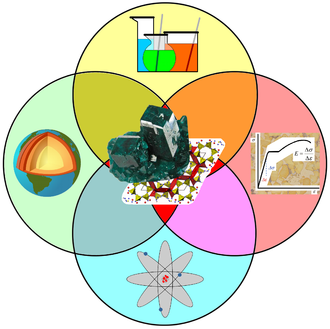
Mineralogy applies principles of chemistry, geology, physics and materials science to the study of minerals
Mineralogy is a subject of geology specializing in the scientific study of the chemistry, crystal structure, and physical (including optical) properties of minerals and mineralized artifacts. Specific studies within mineralogy include the processes of mineral origin and formation, classification of minerals, their geographical distribution, as well as their utilization. (Full article...) -
Image 19
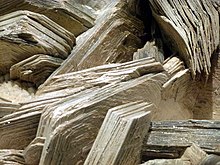
Micas (/ˈmaɪkəz/ MY-kəz) are a group of silicate minerals whose outstanding physical characteristic is that individual mica crystals can easily be split into extremely thin elastic plates. This characteristic is described as perfect basal cleavage. Mica is common in igneous and metamorphic rock and is occasionally found as small flakes in sedimentary rock. It is particularly prominent in many granites, pegmatites, and schists, and "books" (large individual crystals) of mica several feet across have been found in some pegmatites.
Micas are used in products such as drywalls, paints, fillers, especially in parts for automobiles, roofing and shingles, as well as in electronics. The mineral is used in cosmetics and food to add "shimmer" or "frost." (Full article...) -
Image 20
Beryl (/ˈbɛrəl/ BERR-əl) is a mineral composed of beryllium aluminium silicate with the chemical formula Be3Al2Si6O18. Well-known varieties of beryl include emerald and aquamarine. Naturally occurring hexagonal crystals of beryl can be up to several meters in size, but terminated crystals are relatively rare. Pure beryl is colorless, but it is frequently tinted by impurities; possible colors are green, blue, yellow, pink, and red (the rarest). It is an ore source of beryllium. (Full article...) -
Image 21Malachite from the Democratic Republic of the Congo
Malachite is a copper carbonate hydroxide mineral, with the formula Cu2CO3(OH)2. This opaque, green-banded mineral crystallizes in the monoclinic crystal system, and most often forms botryoidal, fibrous, or stalagmitic masses, in fractures and deep, underground spaces, where the water table and hydrothermal fluids provide the means for chemical precipitation. Individual crystals are rare, but occur as slender to acicular prisms. Pseudomorphs after more tabular or blocky azurite crystals also occur. (Full article...) -
Image 22
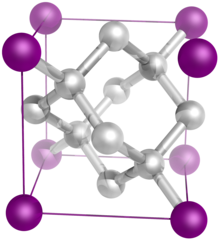
The diamond crystal structure belongs to the face-centered cubic lattice, with a repeated two-atom pattern.
In crystallography, a crystal system is a set of point groups (a group of geometric symmetries with at least one fixed point). A lattice system is a set of Bravais lattices. Space groups are classified into crystal systems according to their point groups, and into lattice systems according to their Bravais lattices. Crystal systems that have space groups assigned to a common lattice system are combined into a crystal family.
The seven crystal systems are triclinic, monoclinic, orthorhombic, tetragonal, trigonal, hexagonal, and cubic. Informally, two crystals are in the same crystal system if they have similar symmetries (though there are many exceptions). (Full article...) -
Image 23Halite from the Wieliczka salt mine, Małopolskie, Poland
Halite (/ˈhælaɪt, ˈheɪlaɪt/ HAL-yte, HAY-lyte), commonly known as rock salt, is a type of salt, the mineral (natural) form of sodium chloride (NaCl). Halite forms isometric crystals. The mineral is typically colorless or white, but may also be light blue, dark blue, purple, pink, red, orange, yellow or gray depending on inclusion of other materials, impurities, and structural or isotopic abnormalities in the crystals. It commonly occurs with other evaporite deposit minerals such as several of the sulfates, halides, and borates. The name halite is derived from the Ancient Greek word for "salt", ἅλς (háls). (Full article...) -
Image 24Quartz crystal cluster from Brazil
Quartz is a hard, crystalline mineral composed of silica (silicon dioxide). The atoms are linked in a continuous framework of SiO4 silicon–oxygen tetrahedra, with each oxygen being shared between two tetrahedra, giving an overall chemical formula of SiO2. Quartz is, therefore, classified structurally as a framework silicate mineral and compositionally as an oxide mineral. Quartz is the second most abundant mineral in Earth's continental crust, behind feldspar.
Quartz exists in two forms, the normal α-quartz and the high-temperature β-quartz, both of which are chiral. The transformation from α-quartz to β-quartz takes place abruptly at 573 °C (846 K; 1,063 °F). Since the transformation is accompanied by a significant change in volume, it can easily induce microfracturing of ceramics or rocks passing through this temperature threshold.
There are many different varieties of quartz, several of which are classified as gemstones. Since antiquity, varieties of quartz have been the most commonly used minerals in the making of jewelry and hardstone carvings, especially in Europe and Asia.
Quartz is the mineral defining the value of 7 on the Mohs scale of hardness, a qualitative scratch method for determining the hardness of a material to abrasion. (Full article...) -
Image 25

Kaolinite (/ˈkeɪ.ələˌnaɪt, -lɪ-/ KAY-ə-lə-nyte, -lih-; also called kaolin) is a clay mineral, with the chemical composition: Al2Si2O5(OH)4. It is a layered silicate mineral, with one tetrahedral sheet of silica (SiO4) linked through oxygen atoms to one octahedral sheet of alumina (AlO6).
Kaolinite is a soft, earthy, usually white, mineral (dioctahedral phyllosilicate clay), produced by the chemical weathering of aluminium silicate minerals like feldspar. It has a low shrink–swell capacity and a low cation-exchange capacity (1–15 meq/100 g).
Rocks that are rich in kaolinite, and halloysite, are known as kaolin (/ˈkeɪ.əlɪn/) or china clay. In many parts of the world kaolin is colored pink-orange-red by iron oxide, giving it a distinct rust hue. Lower concentrations of iron oxide yield the white, yellow, or light orange colors of kaolin. Alternating lighter and darker layers are sometimes found, as at Providence Canyon State Park in Georgia, United States.
Kaolin is an important raw material in many industries and applications. Commercial grades of kaolin are supplied and transported as powder, lumps, semi-dried noodle or slurry. Global production of kaolin in 2021 was estimated to be 45 million tonnes, with a total market value of $US4.24 billion. (Full article...)
Selected mineralogist
-
Image 1

William Hyde Wollaston FRS (/ˈwʊləstən/; 6 August 1766 – 22 December 1828) was an English chemist and physicist who is famous for discovering the chemical elements palladium and rhodium. He also developed a way to process platinum ore into malleable ingots. (Full article...) -
Image 2William "Bill" Wallace Pinch (August 15, 1940 – April 1, 2017) was a mineralogist from Rochester, New York. The Mineralogical Association of Canada has an award named after him, the Pinch Medal, "to recognize major and sustained contributions to the advancement of mineralogy by members of the collector-dealer community."
The Pinch Medal has been awarded to a deserving mineralogist every other year since it was first awarded to Pinch in 2001, and is given at the Tucson Mineral Show in February.
Pinch was also a notable mineral collector. His collection was sold in 1989 to the Canadian Museum of Nature for $US 3.5 million, and will be documented in a book to be published in 2018. (Full article...) -
Image 3

Lars Fredrik Svanberg
Lars Fredrik Svanberg (13 May 1805 – 16 July 1878) was a Swedish chemist and mineralogist. (Full article...) -
Image 4Otto Heinrich Erdmannsdörffer (11 March 1876, Heidelberg – 19 April 1955, Heidelberg) was a German mineralogist and petrographer, known for his analysis of rocks and minerals found in the Odenwald, the Black Forest and the Harz Mountains. He was the son of historian Bernhard Erdmannsdörffer.
He studied natural sciences at the universities of Heidelberg and Strasbourg, receiving his doctorate in 1900. For the next twelve years he worked as a research assistant at the Prussian Geological Survey, and in the meantime, obtained his habilitation in mineralogy and petrology from the University of Berlin (1908). In 1912 he was appointed chair of mineralogy and petrology at the Technical University of Hannover, and in 1926 returned to Heidelberg, where he succeeded Ernst Anton Wülfing as director of the mineralogical-petrographic institute. In 1932 he was named academic rector at Heidelberg. (Full article...) -
Image 5
Johan Afzelius (13 June 1753 in Larv – 20 May 1837 in Uppsala) was a Swedish chemist and notable as the doctoral advisor of one of the founders of modern chemistry, Jöns Jacob Berzelius. He was the brother of botanist Adam Afzelius and physician Pehr von Afzelius.
Afzelius received his PhD at Uppsala University in 1776 under Torbern Olof Bergman. In 1780 he became a lecturer at Uppsala and in 1784 a professor of chemistry. From 1792 to 1797 he undertook research trips to Norway, Denmark and Russia in order to study mineral deposits and to visit scientific institutions. His remarkable mineral collection became part of Uppsala University's mineral cabinet. (Full article...) -
Image 6
Arthur Aikin FLS FGS (19 May 1773 – 15 April 1854) was an English chemist, mineralogist and scientific writer, and was a founding member of the Chemical Society (now the Royal Society of Chemistry). He first became its treasurer in 1841, and later became the society's second president. (Full article...) -
Image 7Kurt von Gehlen (9 February 1927 in Kiel/Germany – 17 May 1995 in Königstein im Taunus) was a German mineralogist and professor. (Full article...)
-
Image 8João da Silva Barbosa or João da Silva Feijó, (1760 in Rio de Janeiro – 1824), was a naturalist, mineralogist and Portuguese soldier, born in Brazil.
João da Silva Feijó studied philosophy and mathematics at the University of Coimbra and adopted the name Feijó in homage to Benito Jerónimo Feijoo, Spanish philosopher, who at the time was respected among natural history students. (Full article...) -
Image 9József Sándor Krenner or Joseph Krenner (3 March 1839 – 6 January 1920) was a Hungarian mineralogist. He discovered several new minerals.
Krenner was born in Buda and studied at the University of Pest, Vienna and Tübingen mineralogy and geology. He received his Ph.D. in 1865 for work with Friedrich August Quenstedt in Tübingen. Krenner worked in the mineralogy section of the Hungarian National Museum. From 1870 on he also lectured at the Technical University of Budapest. In 1888 he became a member of the Hungarian Academy of Science.
Krenner discovered several new minerals, for example, Krennerite which he discovered in 1877 in Sacaramb, Romania. The mineral is obviously named after himself. Another mineral he discovered was Semseyite, the lead antimony sulfide discovered in 1881 was named after Andor Semsey (1833–1923), a Hungarian nobleman and mineralogist. (Full article...) -
Image 10Leonard James Spencer CBE FRS (7 July 1870 – 14 April 1959) was a British geologist. He was an Honorary member of the Royal Geological Society of Cornwall, and also a recipient of its Bolitho Medal. He was president of the Mineralogical Society of Great Britain and Ireland from 1936 to 1939. In mineralogy, Spencer was an original investigator who described several new minerals, including miersite, tarbuttite and parahopeite. He also did important work as a curator, editor and bibliographer. He was the third person to receive the Roebling Medal, the highest award of the Mineralogical Society of America. In 1937, he was awarded the Murchison Medal of the Geological Society of London. He wrote at least 146 articles for the Encyclopædia Britannica Eleventh Edition.
His daughter, Penelope Spencer became a successful free-style dancer and choreographer. (Full article...) -
Image 11

André Laugier (1770–1832)
André Laugier (1 August 1770, in Lisieux – 19 April 1832, in Paris) was a French chemist, pharmacist and mineralogist. He was a cousin to famed chemist Antoine François Fourcroy and the father of astronomer Paul Auguste Ernest Laugier (1812–1872).
He received his education in his hometown of Lisieux, and during the French Revolution, was tasked with collecting church bells in Bretagne in order for them to be melted down for the production of cannons. In 1794 he was employed as head of the gunpowder and saltpeter works at the Comite de salut public. In 1797 he received his master's degree in pharmacy, and subsequently taught classes in chemistry and pharmacy at the military training schools in Toulon and Lille. (Full article...) -
Image 12

Antonio D'Achiardi (28 November 1839, in Pisa – 10 December 1902, in Pisa) was an Italian geologist and mineralogist known for his mineralogical studies of Tuscany. He was the father of the mineralogist Giovanni D'Achiardi [it], and the artist, Pietro D'Achiardi.
In 1859 he received his doctorate in sciences from the University of Pisa, afterwards working as an assistant for chemistry (from 1861). Three months after this appointment, he lost the use of his left eye due to a laboratory accident involving nitric acid. He subsequently abandoned his career in chemistry, and instead devoted his attention to geology and mineralogy, becoming a student of Giuseppe Meneghini. He later became a professor of geology at Pavia and in 1874 was appointed a professor of mineralogy at the University of Pisa. In 1881 he established a laboratory of mineralogy at Pisa. (Full article...) -
Image 13

Harry von Eckermann, 1916
Harry von Eckermann (1886–1969) was a Swedish industrialist, mineralogist and geologist. His studies were centered around anorogenic alkaline igneous rocks occurring in the Baltic Shield. Following this line he studied the Alnö Complex, Norra Kärr Alkaline Complex and various Rapakivi granites.
In a 1948 publication on Alnö, von Eckermann correctly claimed a magmatic origin of carbonatite, albeit his finds were only widely accepted after the Ol Doinyo Lengai eruption of carbonatite lava in the 1960s showed contemporary evidence on the existence of such magmas. In relation to the mid-20th century granitization controversy von Eckermann rejected the notion that rapakivi granites were Jotnian sediments turned into granite. (Full article...) -
Image 14
John Walker FRSE (1731–1803) was a Scottish minister and natural historian. He was Regius Professor of Natural history at the University of Edinburgh from 1779 to 1803. He was joint founder of the Royal Society of Edinburgh in 1783 and Moderator of the General Assembly of the Church of Scotland in 1790. (Full article...) -
Image 15

James Nicol
James Nicol FRSE FGS (12 August 1810 – 8 April 1879) was a Scottish geologist. (Full article...) -
Image 16Archibald Bruce (February 1777 – February 22, 1818) was an American physician and mineralogist. (Full article...)
-
Image 17Portrait by Ambroise Tardieu (1825)
Pierre Louis Antoine Cordier (31 March 1777 – 30 March 1861) was a French geologist and mineralogist, and a founder of the French Geological Society. He was professor of geology at the Muséum national d'histoire naturelle in Paris from 1819 to 1861, and was responsible for the development of the geological gallery in the museum. (Full article...) -
Image 18William Sansom Vaux (May 19, 1811 – May 5, 1882) was an American mineralogist from Pennsylvania. (Full article...)
-
Image 19

Johann Carl Gehler (17 May 1732 – 6 May 1796) was a German physician, mineralogist, and anatomist.
Born 17 May 1732 in Görlitz, Gehler studied medicine from 1751 to 1758 at the University of Leipzig, where he was a pupil of physician and botanist Christian Gottlieb Ludwig. While a student at Leipzig, he furthered his interest in natural sciences, publishing the mineralogical treatise, De characteribus fossilium externis (1757), as a result. Following graduation, he continued his education by studying mineralogy in Freiberg and obstetrics in Strasbourg as a student of Johann Jakob Fried (1689–1769). (Full article...) -
Image 20
Waldemar Christofer Brøgger ForMemRS FRSE (10 November 1851 – 17 February 1940) was a Norwegian geologist and mineralogist. His research on Permian igneous rocks (286 to 245 million years ago) of the Oslo district greatly advanced petrologic theory on the formation of rocks. (Full article...) -
Image 21Charles-Victor Mauguin (French: [ʃaʁl.vik.tɔʁ mo.gɛ̃]; 19 September 1878 – 25 April 1958), more often Charles Mauguin, was a French mineralogist and crystallographer. He and Carl Hermann invented an international standard notation for crystallographic groups called Hermann–Mauguin notation (also sometimes called international notation). (Full article...)
-
Image 22William James Lewis F.R.S. (10 January 1847 – 16 April 1926) was a Welsh mineralogist. (Full article...)
-
Image 23

Jean-Claude Delamétherie
Jean-Claude Delamétherie (also de La Métherie, de Lamétherie, 4 September 1743 – 1 July 1817) was a French mineralogist, geologist and paleontologist. (Full article...) -
Image 24Warren D. Huff (born April 16, 1937) is Professor of Geology at the University of Cincinnati (UC). He specializes in clay mineralogy, researching the remnants of ancient volcanic eruptions.
He received his BA from Harvard College, 1959 and his PhD from University of Cincinnati, 1963. He has served as assistant professor at UC 1963-1969, associate professor 1969-1985, full professor 1985 to date. He teaches introductory geology sequence. (Full article...) -
Image 25
Alexandre Brongniart (5 February 1770 – 7 October 1847) was a French chemist, mineralogist, geologist, paleontologist, and zoologist, who collaborated with Georges Cuvier on a study of the geology of the region around Paris. Observing fossil content as well as lithology in sequences, he classified Tertiary formations and was responsible for defining 19th century geological studies as a subject of science by assembling observations and classifications.
Brongniart was also the founder of the Musée national de Céramique-Sèvres (National Museum of Ceramics), having been director of the Sèvres Porcelain Factory from 1800 to 1847. (Full article...)
Related portals
Get involved
For editor resources and to collaborate with other editors on improving Wikipedia's Minerals-related articles, see WikiProject Rocks and minerals.
General images
-
Image 1Diamond is the hardest natural material, and has a Mohs hardness of 10. (from Mineral)
-
Image 2Sphalerite crystal partially encased in calcite from the Devonian Milwaukee Formation of Wisconsin (from Mineral)
-
Image 3Schist is a metamorphic rock characterized by an abundance of platy minerals. In this example, the rock has prominent sillimanite porphyroblasts as large as 3 cm (1.2 in). (from Mineral)
-
Image 4An example of elbaite, a species of tourmaline, with distinctive colour banding. (from Mineral)
-
Image 6Hübnerite, the manganese-rich end-member of the wolframite series, with minor quartz in the background (from Mineral)
-
Image 7Red cinnabar (HgS), a mercury ore, on dolomite. (from Mineral)
-
Image 9Black andradite, an end-member of the orthosilicate garnet group. (from Mineral)
-
Image 13Mohs Scale versus Absolute Hardness (from Mineral)
-
Image 14Epidote often has a distinctive pistachio-green colour. (from Mineral)
-
Image 15Native gold. Rare specimen of stout crystals growing off of a central stalk, size 3.7 x 1.1 x 0.4 cm, from Venezuela. (from Mineral)
-
Image 16Pink cubic halite (NaCl; halide class) crystals on a nahcolite matrix (NaHCO3; a carbonate, and mineral form of sodium bicarbonate, used as baking soda). (from Mineral)
-
Image 17Perfect basal cleavage as seen in biotite (black), and good cleavage seen in the matrix (pink orthoclase). (from Mineral)
-
Image 20Muscovite, a mineral species in the mica group, within the phyllosilicate subclass (from Mineral)
-
Image 21Mohs hardness kit, containing one specimen of each mineral on the ten-point hardness scale (from Mohs scale)
-
Image 22Asbestiform tremolite, part of the amphibole group in the inosilicate subclass (from Mineral)
-
Image 23Gypsum desert rose (from Mineral)
-
Image 26When minerals react, the products will sometimes assume the shape of the reagent; the product mineral is termed a pseudomorph of (or after) the reagent. Illustrated here is a pseudomorph of kaolinite after orthoclase. Here, the pseudomorph preserved the Carlsbad twinning common in orthoclase. (from Mineral)
In the news
- 3 May 2024 –
- Panama bans First Quantum Minerals from extracting copper following the closure of its Cobre Panamá mine last year. (Reuters) (The Globe and Mail)
Did you know ...?
- ... that the uncommon mineral aguilarite (pictured), named for discoverer Ponciano Aguilar, is known from the Americas, Europe, Asia, and Australasia?
- ... that the thallium-rich mineral lorandite from the Allchar deposit is being used to determine the flux of solar neutrinos?
- ... that seamanite is known from only four locations, with three in Michigan and one in Australia?
- ...that jerrygibbsite ((Mn,Zn)9(SiO4)4(OH)2) is a rare mineral of which there are only five known samples in the world?
Subcategories
Topics
| Overview | ||
|---|---|---|
| Common minerals | ||
Ore minerals, mineral mixtures and ore deposits | |||||||||
|---|---|---|---|---|---|---|---|---|---|
| Ores |
| ||||||||
| Deposit types | |||||||||
| Borates | |||||
|---|---|---|---|---|---|
| Carbonates | |||||
| Oxides |
| ||||
| Phosphates | |||||
| Silicates | |||||
| Sulfides | |||||
| Other |
| ||||
| Crystalline | |||||||
|---|---|---|---|---|---|---|---|
| Cryptocrystalline | |||||||
| Amorphous | |||||||
| Miscellaneous | |||||||
| Notable varieties |
| ||||||
| Oxide minerals |
| ||||
|---|---|---|---|---|---|
| Silicate minerals | |||||
| Other | |||||
Gemmological classifications by E. Ya. Kievlenko (1980), updated | |||||||||
| Jewelry stones |
| ||||||||
| Jewelry-Industrial stones |
| ||||||||
| Industrial stones |
| ||||||||
Mineral identification | |
|---|---|
| "Special cases" ("native elements and organic minerals") |
|
|---|---|
| "Sulfides and oxides" |
|
| "Evaporites and similars" |
|
| "Mineral structures with tetrahedral units" (sulfate anion, phosphate anion, silicon, etc.) |
|
Associated Wikimedia
The following Wikimedia Foundation sister projects provide more on this subject:
-
 Commons
Commons
Free media repository -
 Wikibooks
Wikibooks
Free textbooks and manuals -
 Wikidata
Wikidata
Free knowledge base -
 Wikinews
Wikinews
Free-content news -
 Wikiquote
Wikiquote
Collection of quotations -
 Wikisource
Wikisource
Free-content library -
 Wikiversity
Wikiversity
Free learning tools -
 Wiktionary
Wiktionary
Dictionary and thesaurus
References
-

-

-

-

-
Random portal
Purge server cache



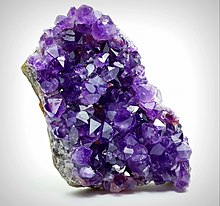









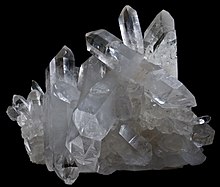




















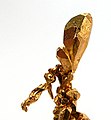






















Well, that’s interesting to know that Psilotum nudum are known as whisk ferns. Psilotum nudum is the commoner species of the two. While the P. flaccidum is a rare species and is found in the tropical islands. Both the species are usually epiphytic in habit and grow upon tree ferns. These species may also be terrestrial and grow in humus or in the crevices of the rocks.
View the detailed Guide of Psilotum nudum: Detailed Study Of Psilotum Nudum (Whisk Fern), Classification, Anatomy, Reproduction